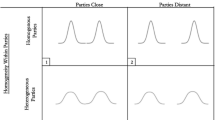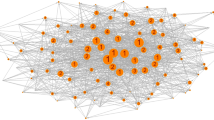Abstract
The people we associate with everyday have an important influence on our exposure and reactions to political stimuli. Social network members in particular can have a dramatic impact on our political views and behavior. Prior research suggests that these attitudinal differences may reflect the information available in a social network: attitudinally congruent networks expose individuals to supporting positions, bolstering their views, while heterogeneous networks provide information on both sides of an issue, generating doubt and ambivalence. In contrast, the current studies examine the effects of individuals’ networks in motivating them to find and engage with new political information on their own. Using ANES panel data, a laboratory-based information board session that examines behavior in detail, and an experimental design that manipulates network composition, we find that individuals in attitudinally heterogeneous social networks are more likely to seek out and attend to political information. They spend more time looking for political information, and then (having found it) spend more time reviewing that new information compared to those whose network members are more like-minded. An experimental study further demonstrates that network composition causally determines these information-seeking preferences. Implications for democratic citizenship in light of these findings are discussed.





Similar content being viewed by others
Notes
Absolute values were used because only a network that completely agrees with an individual (not disagrees equally in both directions) should suppress openness to other views and bolster self-confidence, whereas disagreeing in either (or both) directions should increase awareness of differing positions and increase doubt of one’s own.
The current analyses are an aspect of a larger, more complex study. Here we include only participants in the experimental condition relevant to our current purpose, specifically those who saw the information board in question (following a warm-up board), rather than participants in conditions with minimal control over information exposure.
There were initially 60 participants, but we dropped one outlier who did not select any information over the course of 4 minutes in the session, four participants who rated their English comprehension as only moderate or less, and four participants who failed to provide any information on their party identification.
For more information about the DPTE software, please visit http://dpte.polisci.uiowa.edu/dpte/.
Due to some limitations in the DPTE computer program, the social network questionnaire was administered via pencil and paper. The separation of this questionnaire from the rest of the computer-based study also masked the purpose of these items as a vital independent variable in the study.
We examined alternate causal routes by running analyses on study 2 data that control for network heterogeneity on a separate issue, processing speed, need for closure, political interest, and social desirability, and found the results substantively unaltered (see Appendix B for full models and explanation).
These data were originally part of a larger experiment designed to examine the consequences of exposure to various types of social information.
For discussion by NPR, see http://www.npr.org/2011/01/17/132934543/depression-on-the-rise-in-college-students.
E.g. at the University of Chicago: http://chicagomaroon.com/2002/04/09/news-in-brief-28/.
E.g. at Harvard: http://www.thecrimson.com/article/2013/2/22/mental-health-yard-rally/.
References
Bello, J., & Rolfe, M. (in press). Is influence mightier than selection? Forging agreement in discussion networks during a campaign. Social Networks.
Ben-Nun Bloom, P., & Levitan, L. C. (2011). We’re closer than I thought: Social network heterogeneity, morality, and political persuasion. Political Psychology, 32(4), 643–665.
Berelson, B. R., Lazarsfeld, P. F., & McPhee, W. N. (1954). Voting: A study of opinion formation in a presidential campaign. Chicago: University of Chicago Press.
Burt, R. S. (1985). General social survey network items. Connections, 8(1), 19–23.
Cacioppo, J. T., & Petty, R. E. (1982). The need for cognition. Journal of Personality and Social Psychology, 42(1), 116–131.
Campbell, A., Converse, P. E., Miller, W. E., & Stokes, D. E. (1960). The American voter. New York: Wiley.
Chen, S., & Chaiken, S. (1999). The heuristic-systematic model in its broader context. In S. Chaiken & Y. Trope (Eds.), Dual-process theories in social psychology (pp. 73–96). New York: Guilford.
Converse, P. (1964). The nature of belief systems in mass publics. In D. Apter (Ed.), Ideology and discontent (pp. 260–261). New York: Free Press.
Delli Carpini, M. X., & Keeter, S. (1996). What Americans know about politics and why it matters. New Haven: Yale University Press.
DeWall, C. N., Visser, P. S., & Levitan, L. C. (2006). Openness to attitude change as a function of temporal perspective. Personality and Social Psychology Bulletin, 32(8), 1010–1023.
Festinger, L. (1954). A theory of social comparison processes. Indianapolis: Bobbs-Merrill.
Fishkin, J. S. (1991). Democracy and deliberation: New directions for democratic reform. New Haven: Cambridge University Press.
Fiske, S. T., & Taylor, S. E. (1991). Social cognition. New York: Mcgraw-Hill Book Company.
Goel, S., Mason, W., & Watts, D. J. (2010). Real and perceived attitude agreement in social networks. Journal of Personality and Social Psychology, 99(4), 611–621.
Holbrook, A. L., & Krosnick, J. A. (2010). Social desirability bias in voter turnout reports tests using the item count technique. Public Opinion Quarterly, 74(1), 37–67.
Huckfeldt, R., & Sprague, J. (1987). Networks in context: The social flow of political information. American Political Science Review, 81(4), 1197–1216.
Huckfeldt, R. R., & Sprague, J. D. (1995). Citizens, politics, and social communication: Information and influence in an election campaign. Cambridge: Cambridge University Press.
Huckfeldt, R., Mendez, J. M., & Osborn, T. (2004). Disagreement, ambivalence, and engagement: The political consequences of heterogeneous networks. Political Psychology, 25(1), 65–95.
Kramer, M. W., Kuo, C. L., & Dailey, J. C. (1997). The impact of brainstorming techniques on subsequent group processes: Beyond generating ideas. Small Group Research, 28(2), 218–242.
Kunda, Z. (1990). The case for motivated reasoning. Psychological Bulletin, 108(3), 480–498.
Kunda, Z. (1999). Social cognition: Making sense of people. Cambridge: The MIT Press.
Lau, R. R., & Redlawsk, D. P. (2001). Advantages and disadvantages of cognitive heuristics in political decision making. American Journal of Political Science, 45(4), 951–971.
Lau, R. R., & Redlawsk, D. P. (2006). How voters decide: Information processing in election campaigns. Cambridge: Cambridge University Press.
Lavine, H. G., Johnston, C. D., & Steenbergen, M. R. (2012). The ambivalent partisan: How critical loyalty promotes democracy. USA: Oxford University Press.
Lazer, D., Rubineau, B., Chetkovich, C., Katz, N., & Neblo, M. (2010). The coevolution of networks and political attitudes. Political Communication, 27(3), 248–274.
Levitan, L. C., & Visser, P. S. (2008). The impact of the social context on resistance to persuasion: Effortful versus effortless responses to counter-attitudinal information. Journal of Experimental Social Psychology, 44(3), 640–649.
Levitan, L. C., & Visser, P. S. (2009). Social network composition and attitude strength: Exploring the dynamics within newly formed social networks. Journal of Experimental Social Psychology, 45(5), 1057–1067.
Long, J. S. (1997). Regression models for categorical and limited dependent variables. Thousand Oaks: SAGE.
Lupia, A. (1994). Shortcuts versus encyclopedias: Information and voting behavior in California insurance reform elections. The American Political Science Review, 88(1), 63–76.
Marcus, G. E., Neuman, W. R., & MacKuen, M. (2000). Affective Intelligence and Political Judgment. Chicago: University of Chicago Press.
McClurg, S. D. (2006). The electoral relevance of political talk: Examining disagreement and expertise effects in social networks on political participation. American Journal of Political Science, 50(3), 737–754.
Mutz, D. C. (2002a). The consequences of cross-cutting networks for political participation. American Journal of Political Science, 46(4), 838–855.
Mutz, D. C. (2002b). Cross-cutting social networks: Testing democratic theory in practice. American Political Science Review, 96(1), 111–126.
Mutz, D. C. (2006). Hearing the other side: Deliberative versus participatory democracy. Cambridge: Cambridge University Press.
Petty, R. E., & Cacioppo, J. T. (1986). The elaboration likelihood model of persuasion. Advances in Experimental Social Psychology, 19, 123–205.
Priester, J. R., & Petty, R. E. (2001). Extending the bases of subjective attitudinal ambivalence: Interpersonal and intrapersonal antecedents of evaluative tension. Journal of Personality and Social Psychology, 80(1), 19–34.
Ryan, J. B. (2010). The effects of network expertise and biases on vote choice. Political Communication, 27(1), 44–58.
Simon, H. A. (1979). Information processing models of cognition. Annual Review of Psychology, 30, 363–396.
Simon, H. A. (1990). Invariants of human behavior. Annual Review of Psychology, 41, 1–20.
Snyder, M. (1974). Self-monitoring of expressive behavior. Journal of Personality and Social Psychology, 30(4), 526–537.
Taber, C., & Lodge, M. (2006). Motivated skepticism in the evaluation of political beliefs. American Journal of Political Science, 50(3), 755–769.
Tomz, M., Wittenberg, J., & King, G. (2003). CLARIFY: Software for interpreting and presenting statistical results. Journal of Statistical Software, 8(1), 1–30.
Tourangeau, R., Rips, L. J., & Rasinski, K. A. (2000). The psychology of survey response. Cambridge: Cambridge University Press.
Visser, P. S., & Mirabile, R. R. (2004). Attitudes in the social context: The impact of social network composition on individual-level attitude strength. Journal of Personality and Social Psychology, 87(6), 779–795.
Welch, M. J. (1974). Infants’ visual attention to varying degrees of novelty. Child Development, 45, 344–350.
Acknowledgments
Previous versions of this paper were presented at meetings of the Midwestern Political Science Association and the International Society for Political Psychology. The authors would like to thank the editors, anonymous reviewers, and discussants for their helpful comments. We would also like to thank Karyn Amira, Mark Lombardi, and April Johnson for their invaluable assistance.
Author information
Authors and Affiliations
Corresponding author
Electronic supplementary material
Below is the link to the electronic supplementary material.
Rights and permissions
About this article
Cite this article
Levitan, L., Wronski, J. Social Context and Information Seeking: Examining the Effects of Network Attitudinal Composition on Engagement with Political Information. Polit Behav 36, 793–816 (2014). https://doi.org/10.1007/s11109-013-9247-z
Published:
Issue Date:
DOI: https://doi.org/10.1007/s11109-013-9247-z




